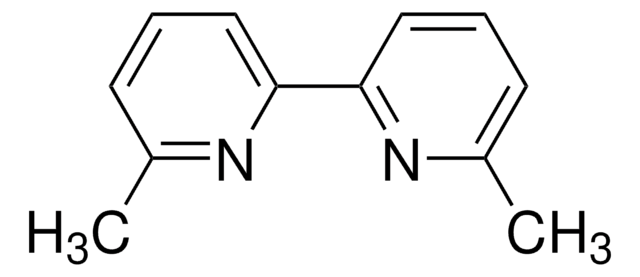550566
2,2′-Bipyridine-4,4′-dicarboxylic acid
98%
Synonym(s):
2,2′-Bipyridyl-4,4′-dicarboxylic acid
About This Item
Recommended Products
Assay
98%
SMILES string
OC(=O)c1ccnc(c1)-c2cc(ccn2)C(O)=O
InChI
1S/C12H8N2O4/c15-11(16)7-1-3-13-9(5-7)10-6-8(12(17)18)2-4-14-10/h1-6H,(H,15,16)(H,17,18)
InChI key
FXPLCAKVOYHAJA-UHFFFAOYSA-N
Looking for similar products? Visit Product Comparison Guide
Application
- Enhanced catalysis of CO2 cycloaddition at ambient pressure through rational design of interpenetrating ZnII/LnIII heterometallic coordination polymers: This study highlights the use of 2,2′-bipyridine-4,4′-dicarboxylic acid in the synthesis of ZnII/LnIII coordination polymers, which exhibit enhanced catalytic performance for CO2 cycloaddition at ambient pressure (Chuasaard et al., 2024).
- Immobilization of a new copper (II) complex dye with multi-walled carbon nanotubes and functional simulation in dye-sensitized solar cell: This research describes the synthesis of a new ligand using 2,2′-bipyridine-4,4′-dicarboxylic acid combined with multiwalled carbon nanotubes for potential applications in dye-sensitized solar cells (Shahbaznejad et al., 2023).
- Impact of Anchoring Groups on the Photocatalytic Performance of Iridium (III) Complexes and Their Toxicological Analysis: The study investigates the photocatalytic performance and toxicological analysis of Iridium (III) complexes using 2,2′-bipyridine-4,4′-dicarboxylic acid as an anchoring unit (Yao et al., 2024).
- Phosphonate-based iron complex for a cost-effective and long cycling aqueous iron redox flow battery: This paper discusses the use of 2,2′-bipyridine-4,4′-dicarboxylic acid in the development of a high redox potential Fe-Dcbpy/CN catholyte for iron redox flow batteries (Nambafu et al., 2024).
- 2, 2′-bipyridine-4, 4′-dicarboxylic acid ligand engineered CsPbBr3 perovskite nanocrystals for enhanced photoluminescence quantum yield with stable display properties: This article explores the use of 2,2′-Bipyridine-4,4′-dicarboxylic acid to improve the optical properties of CsPbBr3 perovskite nanocrystals for display applications (Kumar et al., 2024).
Signal Word
Warning
Hazard Statements
Precautionary Statements
Hazard Classifications
Eye Irrit. 2 - Skin Irrit. 2 - STOT SE 3
Target Organs
Respiratory system
Storage Class Code
11 - Combustible Solids
WGK
WGK 3
Personal Protective Equipment
Certificates of Analysis (COA)
Search for Certificates of Analysis (COA) by entering the products Lot/Batch Number. Lot and Batch Numbers can be found on a product’s label following the words ‘Lot’ or ‘Batch’.
Already Own This Product?
Find documentation for the products that you have recently purchased in the Document Library.
Customers Also Viewed
Our team of scientists has experience in all areas of research including Life Science, Material Science, Chemical Synthesis, Chromatography, Analytical and many others.
Contact Technical Service











